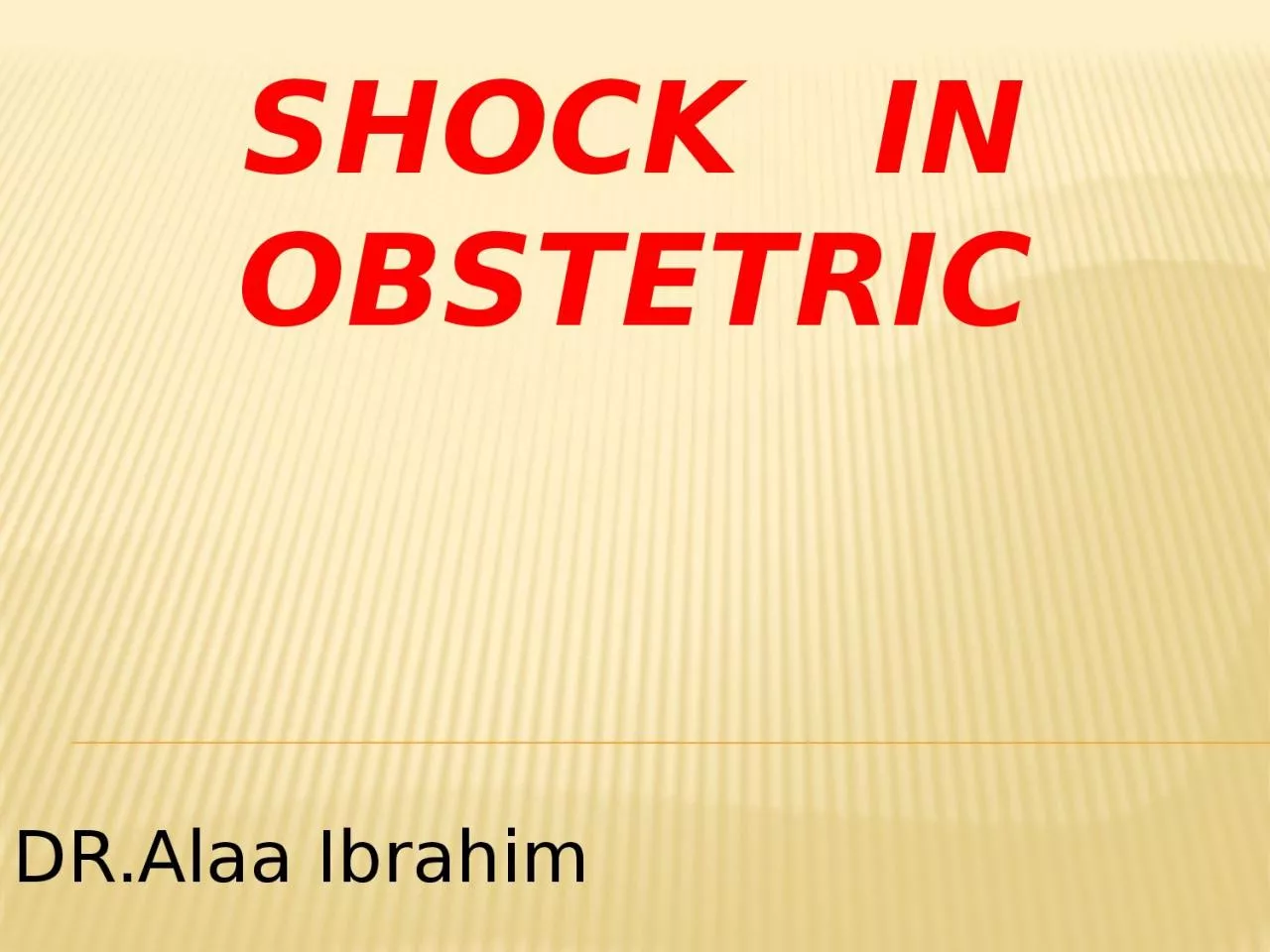

Ibrahim Definitions acute generalized inadequate perfusion below that needed to deliver the oxygen and nutritions for the normal cell function Aetiology there are 4 major classes ID: 1039552
Download Presentation The PPT/PDF document "Shock in obstetric DR.Alaa" is the property of its rightful owner. Permission is granted to download and print the materials on this web site for personal, non-commercial use only, and to display it on your personal computer provided you do not modify the materials and that you retain all copyright notices contained in the materials. By downloading content from our website, you accept the terms of this agreement.
1. Shock in obstetricDR.Alaa Ibrahim
2. Definitions: acute , generalized , inadequate perfusion below that needed to deliver the oxygen and nutrition's for the normal cell function.-
3. Aetiology: there are 4 major classes-1. Hypovolemic shock.2.Septic shock.3.Cardiogenic shock, e.g massive pulmonary embolism, dysarthemia4.Distibutive (neurogenic) shock, spinl cord injury, regional anesthesia anaphylaxis.
4. Pathophysiology:Untreated shock progresses through 3 stages until death occur:-A.compensated:-change in bood pressure , cardiac output compensated by adjustment of haemostatic mechanism, healthy female not require fluid if cause is removed.B.Decompensated:- maximum mechanical action is acting but tissue perfusion is reduced, impaired vital organ function (heart, brain, kidney)..
5. C.Irreversible:-Acute tubular necrosis.decressed myocardial perfusion and contractility, cellular damage and death.-In Obstetric cases shock is most commonly due to either hemorrhage or sepsis
6. Hypovolemic shockIt is absolute reduction in intravenous volume that lead to decreased cardiac output , tissue perfusion, vasocontraction to perfuse blood for vital organs.
7. Causes :1.massive hemorrhage –A-obvious cause( External).B-Occult like peritoneal haematoma, intra abdominal bleeding.2. Non hemorrhagic--- like extra cellular fluid loss.
8. In pregnancy classified into : Antenatal causes1.Ruptured ectopic pregnancy 2.Incomplete abortion3.Placenta previa.4.Placenta abruption5.Uterine rupture. .
9. Postnatal causes:1.Uterine atony.2. Lacerations.3. chorioamnionites.4. Large placental site.5. Acute uterine inversion.6. Puerperial sepsis
10. - Signs and Symptoms: Hypotension.Rapid weak pulse.Pallor.Sweating.Cold clamy extremities.Oliguria or anurea.Confusion.
11. Complications of Hypovolemic shock :1) Acute renal failure. 2) Pituitary necrosis (Sheehan‟s syndrome). 3) Disseminated intravascular coagulation.
12. .Management:1.Resusitation. -maintain airway: apply high concentration oxygen, assist ventilations as needed .-Place patient in the Trendelenburg position .-Control obvious bleeding.-Restoration of Circulation Volume – insert at least two large pore IV catheters , Crystalloids for initial resuscitation.-Blood-- order at least 6 units , do not insist on cross matched blood if transfusion is urgently needed. -Monitor central venous pressure (CVP) and arterial pressure.
13. Pelvic artery embolization : by using interventional radiological technique , success in women who expected to have major hemorrhage like placental accrete undergoing elective C/S.
14.
15. Balloon Tamponade :by using uterine packing or hydrostatic balloon catheter.-insert the catheter into the uterine cavity.-inflation with warm saline then vaginal packing.-oxytocin infusion to maintain the uterine tone.-Catheter insitue for 12-24 hours.-Fluid is removed gradually and catheter removed in high care area (operative theater)then the vaginal packing.
16.
17. treat the cause:-managment of uterne atony.Management of rupture uterus(0-05%)- Management of acute uterine inversion-
18. Developments in management pf hypovolemia:1. Cell salvage: autologous transfusion with salvaged RBC ..2.Recombinant activated factor 7-Novoseven:
19. Septic shock-Sepsis and hypotension despite adequate fluid resuscitation .-Mortality rate is 3%.-Results from body’s response to bacteria in blood stream .Vessels dilate, become “leaky
20. Pathology :Large inflammatory response leads to massive vasodilatation---cause decrease vascular resistance , increase capillary permability, cardiac depression , hypotension ----decrease tissue pressure , hypoxia , impaired oxygen utilization, ---multiple organ failure , death.
21. Obstetric Causes of Septic shock: 1.Postoperative infections.2. Puerperal sepsis.3.Retained placental tissue.4.Chorioamnionitis .5. Acute pyelonephritis.6.Septic abortion (usually illegal).
22. Symptoms: -patches of discolored skin-noticeably lower amounts of urination-confusion-problems breathing-abnormal heart functions, such as palpitations or rapid heart rate-chills due to fall in body temperature-extreme weakness or lightheadedness
23. Criteria for diagnosis :-Evidence of infection through positive blood culture.-Refractory hypotension.-Require vasopressor or inotropic drugs, despite fluid replacement.
24. Treatment: the earlier sepsis is diagnosed and treated, the more likely you are to survive.1.Once sepsis is diagnosed, call for help and ,you will most likely be admitted to an Intensive Care Unit (ICU) for treatment.
25. 2. Oxygen therapy through a face mask, a tube inserted into nose, or an endotracheal tube inserted into mouth. In severe shortness of breath, a mechanical ventilator may be used.3. warm the patient and IV fluid.4. Inotropic medicines (inotropes), such as dobutamine, stimulate the heart. They increase the strength of heart beat, which helps get oxygen-rich blood to tissues and organs where it's needed.
26. 5. intravenous antibiotics to fight infection. 6. vaso pressure medications – drugs that constrict blood vessels and help increase blood pressure, and flow of blood allow your vital organs to start functioning properly, like dopamine, adrenaline , noradrenaline.7.corticosteroids to help with inflammation.8. In severe cases of sepsis or septic shock, the large decrease in blood pressure and blood flow can kill organ tissue. If this happens, surgery may be required to remove the dead tissue.
27. Thank you